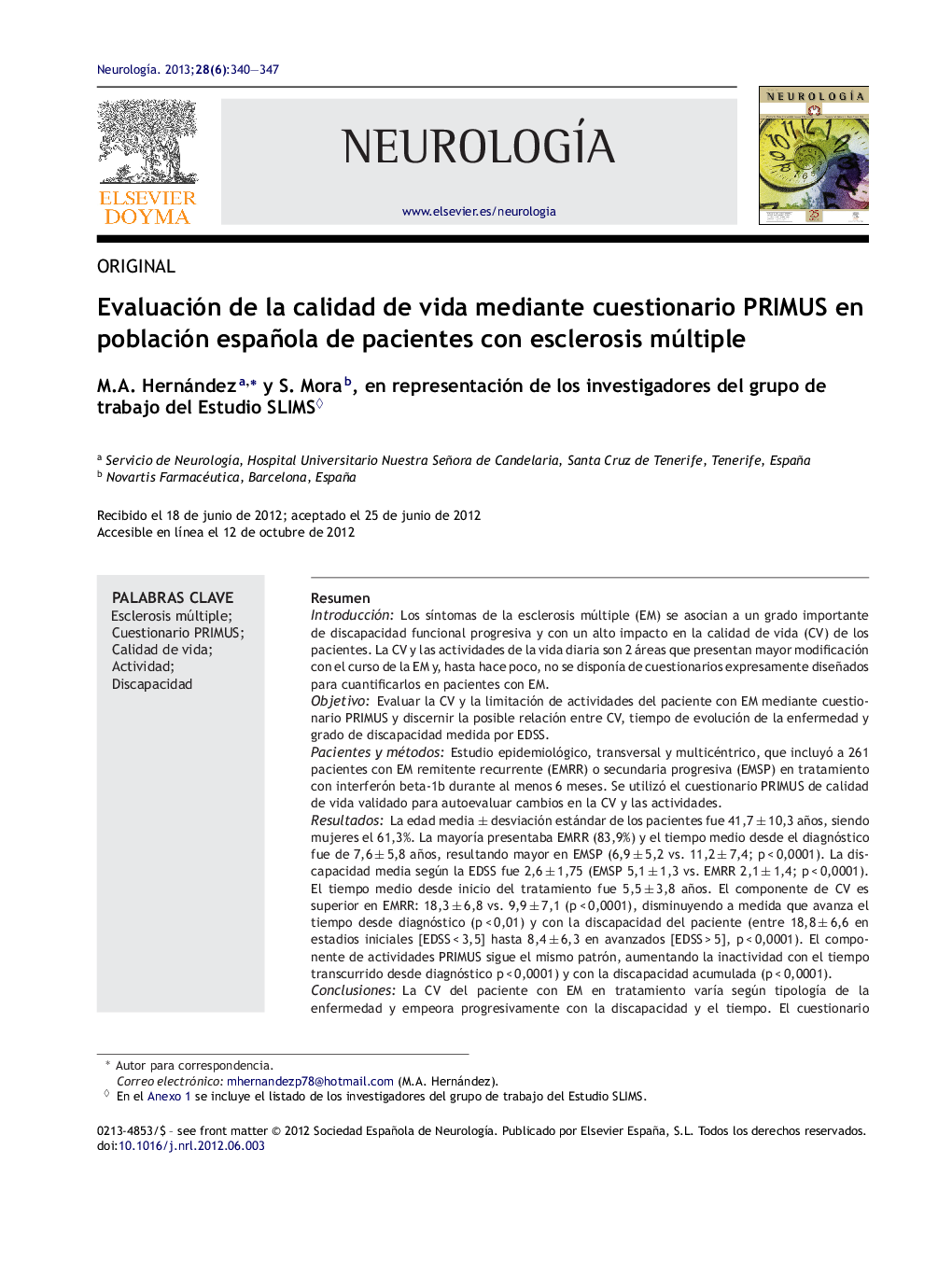| Article ID | Journal | Published Year | Pages | File Type |
|---|---|---|---|---|
| 3076084 | Neurología | 2013 | 8 Pages |
ResumenIntroducciónLos síntomas de la esclerosis múltiple (EM) se asocian a un grado importante de discapacidad funcional progresiva y con un alto impacto en la calidad de vida (CV) de los pacientes. La CV y las actividades de la vida diaria son 2 áreas que presentan mayor modificación con el curso de la EM y, hasta hace poco, no se disponía de cuestionarios expresamente diseñados para cuantificarlos en pacientes con EM.ObjetivoEvaluar la CV y la limitación de actividades del paciente con EM mediante cuestionario PRIMUS y discernir la posible relación entre CV, tiempo de evolución de la enfermedad y grado de discapacidad medida por EDSS.Pacientes y métodosEstudio epidemiológico, transversal y multicéntrico, que incluyó a 261 pacientes con EM remitente recurrente (EMRR) o secundaria progresiva (EMSP) en tratamiento con interferón beta-1b durante al menos 6 meses. Se utilizó el cuestionario PRIMUS de calidad de vida validado para autoevaluar cambios en la CV y las actividades.ResultadosLa edad media ± desviación estándar de los pacientes fue 41,7 ± 10,3 años, siendo mujeres el 61,3%. La mayoría presentaba EMRR (83,9%) y el tiempo medio desde el diagnóstico fue de 7,6 ± 5,8 años, resultando mayor en EMSP (6,9 ± 5,2 vs. 11,2 ± 7,4; p < 0,0001). La discapacidad media según la EDSS fue 2,6 ± 1,75 (EMSP 5,1 ± 1,3 vs. EMRR 2,1 ± 1,4; p < 0,0001). El tiempo medio desde inicio del tratamiento fue 5,5 ± 3,8 años. El componente de CV es superior en EMRR: 18,3 ± 6,8 vs. 9,9 ± 7,1 (p < 0,0001), disminuyendo a medida que avanza el tiempo desde diagnóstico (p < 0,01) y con la discapacidad del paciente (entre 18,8 ± 6,6 en estadios iniciales [EDSS < 3,5] hasta 8,4 ± 6,3 en avanzados [EDSS > 5], p < 0,0001). El componente de actividades PRIMUS sigue el mismo patrón, aumentando la inactividad con el tiempo transcurrido desde diagnóstico p < 0,0001) y con la discapacidad acumulada (p < 0,0001).ConclusionesLa CV del paciente con EM en tratamiento varía según tipología de la enfermedad y empeora progresivamente con la discapacidad y el tiempo. El cuestionario PRIMUS es una herramienta adecuada para la evaluación de la CV y la actividad en pacientes con EM.
IntroductionSymptoms of multiple sclerosis (MS) are associated with significant and progressive functional disability and have a profound impact on patients’ quality of life (QoL). QoL and daily life activities are two areas that suffer major changes during the course of MS and there are currently no questionnaires specifically designed to evaluate these areas in MS patients.PurposeTo evaluate QoL of MS patients using the PRIMUS questionnaire and determine the possible relationship between QoL, duration of disease, and disability measured on the EDSS.Patients and methodsMulti-centre epidemiological and cross-sectional study including 261 patients with relapsing remitting MS (RRMS) or secondary progressive MS (SPMS) treated with interferon beta-1b for at least 6 months. The validated version of the PRIMUS questionnaire was used for patient reporting of changes in QoL and life activities.ResultsMean age of patients was 41.7 ± 10.3 years; 61.3% were women. Most had RRMS (83.9%). Mean time since MS diagnosis was 7.6 ± 5.8 years, and longer in the SPMS group (11.2 ± 7.4 vs 6.9 ± 5.2, P < .0001). Mean EDSS score was 2.6 ± 1.75 (5.1 ± 1.3 in SPMS vs 2.1 ± 1.4 in RRMS, P < .0001). Mean time since start of treatment was 5.5 ± 3.8 years. The PRIMUS QoL component was higher in the RRMS group: 18.3 ± 6.8 vs 9.9 ± 7.1 (P<.0001); it also decreased with increases in both time since diagnosis (P < .01) and disability scores (from 18.8 ± 6.6 in early stages [EDSS < 3.5] to 8.4 ± 6.3 in advanced stages [EDSS > 5], P < .0001). The PRIMUS activity limitations component followed the same pattern: activity became more limited with increases in time since diagnosis (P < .0001) and overall disability (P < .0001).ConclusionsQoL in MS patients varies according to the disease type, and it worsens progressively over time and with increasing disability. The PRIMUS questionnaire is a good tool for assessing QoL and activity in patients with MS.
